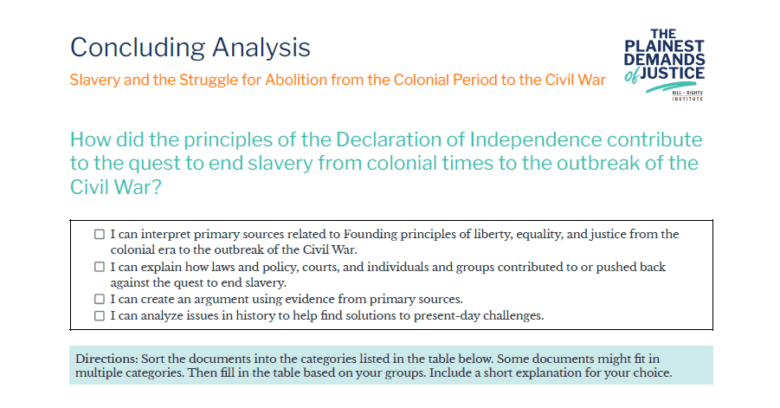Concluding Analysis: The Struggle for Abolition
How did the principles of the Declaration of Independence contribute to the quest to end slavery from colonial times to the outbreak of the Civil War?
- I can interpret primary sources related to Founding principles of liberty, equality, and justice from the colonial era to the outbreak of the Civil War.
- I can explain how laws and policy, courts, and individuals and groups contributed to or pushed back against the quest to end slavery.
- I can create an argument using evidence from primary sources.
- I can analyze issues in history to help find solutions to present-day challenges.
Directions: Sort the documents into the categories listed in the table below. Some documents might fit in multiple categories. Then fill in the table based on your groups. Include a short explanation for your choice.
| Document Title and Date | Laws and Policy | The Courts | “We the People” – individuals and groups |
|---|---|---|---|
| Enactment of Hereditary Slavery Law, Virginia, 1662 | Laws codifying slavery | ||
| Germantown Friends Protest Against Slavery, 1688 | |||
| An Act for the Better Ordering and Governing of Negroes and Other Slaves, South Carolina, 1740 | |||
| John Woolman, “Some Considerations on the Keeping of Negroes,” 1754 | |||
| Thomas Paine, “African Slavery in America,” 1775 | |||
| Belinda Sutton, Petition to the Commonwealth of Massachusetts, 1783 | |||
| Correspondence between Benjamin Banneker and Thomas Jefferson, August, 1791 | |||
| Ohio State Constitution, 1803, and Black Code, 1804 | |||
| U.S. Congress: An Act to Prohibit the Importation of Slaves, 1807 | |||
| James Forten, from Letter I: Letters from a Man of Color, on a Late Bill before the Senate of Pennsylvania, 1813 | |||
| U.S. Congress: An Act to Authorize the People of the Missouri Territory to Form a Constitution and State Government (Missouri Compromise), 1820 | |||
| David Walker, Appeal, in Four Articles, 1829 | |||
| The Underground Railroad and Networks to Freedom | |||
| Maria Stewart Advocates Education for African American Women, 1832 | |||
| William Lloyd Garrison, American Anti-Slavery Society Declaration of Sentiments, 1833 | |||
| John C. Calhoun, Speech on Abolition Petitions, 1837 | |||
| U.S. Supreme Court, U.S. v. Amistad 40 US 518, 1841 | |||
| Frederick Douglass, Narrative of the Life of Frederick Douglass, an American Slave, 1845 | |||
| Sojourner Truth, “Ain’t I a Woman?”, 1851 | |||
| Solomon Northup, Twelve Years a Slave, 1853 | |||
| George Fitzhugh, Sociology for the South, or, The Failure of Free Society, 1854 | |||
| U.S. Congress, An Act to Organize the Territories of Nebraska and Kansas (Kansas-Nebraska Act), 1854 | |||
| Abraham Lincoln, Speech on the Repeal of the Missouri Compromise, 1854 | |||
| U.S. Supreme Court, Dred Scott v. Sandford 60 US 393, 1856 | |||
| John Brown’s Last Speech, 1859 | |||
| Harriet Jacobs, Incidents in the Life of a Slave Girl, 1860 | |||
| Chart: Slave population in 1860 |
- Trace the evolution of the abolitionist cause based on the documents provided. Consider the role of religion, politics, blacks, and whites.
- The codification of slavery in the colonial era formalized chattel slavery in the United States. What does this mean, and why is it significant?
- Despite a long history of protest, slavery endured in the United States for almost 100 years. Why did it take so long for slavery to be abolished? What consequences might have resulted from its 100-year existence?
- How were laws, courts, and individuals and groups’ words and actions complementary and how were they in conflict in their treatment of slavery and enslaved people? In other words, did the courts and laws’ decisions support each other, or did they contradict each other? Did individuals and groups work within the confines of current laws or policies or push back against them? Give examples from specific documents to support your answer.
- How were Founding principles of liberty, equality, and justice invoked or ignored in the quest to end slavery from the colonial era to the outbreak of the Civil War? Support your answer using evidence from the primary sources provided, as well as your own knowledge of U.S. history.
